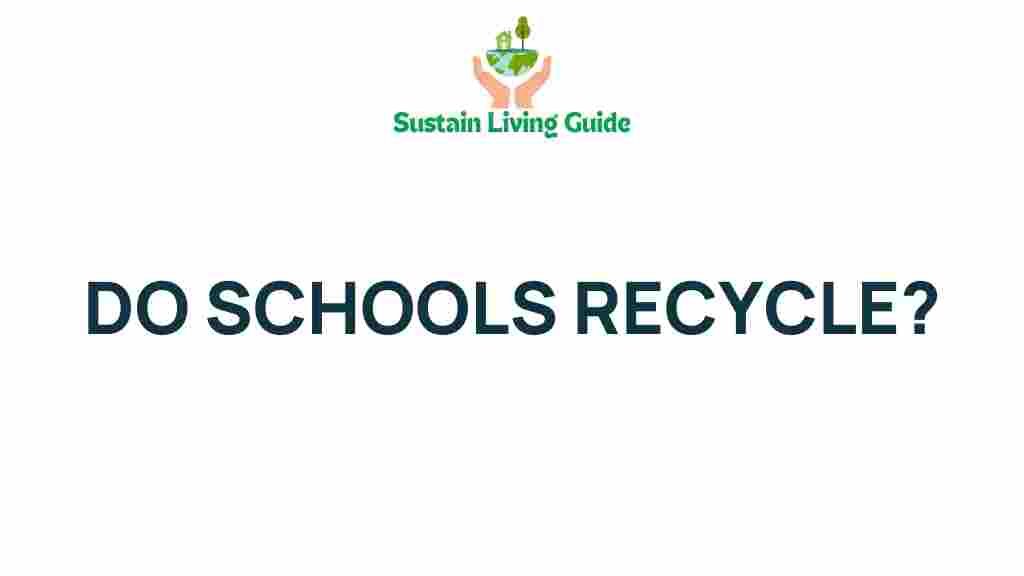Uncovering the Truth: Do Schools Really Recycle?
In an era where environmental sustainability is becoming increasingly important, the role of schools in promoting recycling practices has come under scrutiny. Schools serve as a microcosm of society, and their approach to recycling can greatly influence students’ attitudes toward environmental responsibility. In this article, we will explore the recycling initiatives implemented in schools, the challenges they face, and how effective these programs truly are.
The Importance of Recycling in Schools
Recycling in schools is not just about reducing waste; it’s about educating future generations on sustainable practices. Here are several reasons why recycling in educational institutions is crucial:
- Environmental Impact: Schools generate a significant amount of waste daily. Implementing recycling programs can help reduce landfill contributions.
- Educational Opportunities: Recycling initiatives can serve as hands-on learning experiences for students, teaching them about waste management and environmental stewardship.
- Community Leadership: Schools can lead by example, encouraging families and communities to adopt eco-friendly practices.
- Cost Savings: Reducing waste can lower disposal costs for schools, allowing funds to be redirected to educational programs.
Understanding School Recycling Programs
Many schools have implemented recycling programs, but the effectiveness varies widely. Here’s a step-by-step look at how these programs typically operate:
1. Assessing Waste Management Needs
The first step for any school looking to start or improve its recycling program is to conduct a waste assessment. This involves analyzing the types and quantities of waste generated within the school. Key components include:
- Identifying recyclable materials (paper, plastic, metal, etc.)
- Estimating the volume of waste produced
- Understanding the current disposal methods
2. Setting Up Recycling Stations
Once the assessment is complete, the next step involves setting up designated recycling stations throughout the school. These should be:
- Clearly labeled to avoid contamination
- Located in high-traffic areas for easy access
- Accompanied by educational signage explaining what can and cannot be recycled
3. Educating Students and Staff
Education is vital to the success of any recycling program in schools. Engaging students and staff through workshops, assemblies, and classroom lessons can significantly enhance participation. Consider the following strategies:
- Organize competitions to create excitement around recycling
- Incorporate recycling topics into the curriculum
- Provide incentives for classes that excel in recycling efforts
4. Monitoring and Evaluation
Continuous monitoring is essential to evaluate the effectiveness of the recycling program. This can include:
- Regularly weighing recycled materials
- Soliciting feedback from students and staff
- Adjusting the program based on findings and changing needs
Challenges Faced by Schools
Despite the best efforts, many schools encounter challenges when it comes to recycling. Some of these challenges include:
- Lack of Awareness: Not all students and staff may be aware of what materials can be recycled.
- Contamination: Improper disposal of non-recyclable items can lead to contamination, making entire batches of recycling unusable.
- Funding Limitations: Budget constraints can limit the resources available for effective recycling programs.
- Inconsistent Participation: Without ongoing education and motivation, participation levels can decline.
Troubleshooting Common Recycling Issues
Schools can face several common problems with their recycling programs. Here are some troubleshooting tips to enhance effectiveness:
1. Increase Awareness
If awareness is low, consider implementing a school-wide campaign. Use posters, announcements, and newsletters to keep recycling at the forefront of students’ minds. Educating students about the benefits of recycling can foster a culture of sustainability.
2. Address Contamination
<pTo combat contamination, regularly review what can be recycled and make sure this information is visible at recycling stations. You might even create a short video or presentation explaining the importance of proper recycling practices.
3. Secure Funding
Explore grants and community partnerships to secure funding for recycling initiatives. Many organizations support educational projects focused on sustainability. For more information on potential funding sources, check out this resource.
4. Foster a Community Culture
Engage families and the local community in the recycling efforts. Host clean-up days, recycling drives, or educational workshops that involve parents and local businesses. This not only increases participation but also strengthens community ties.
Success Stories: Schools Leading the Way
While challenges exist, many schools have successfully implemented recycling programs. Here are a few inspiring examples:
- Green School Program: A district in California introduced a comprehensive recycling program that resulted in a 30% reduction in waste over two years.
- Student-Led Initiatives: A high school in New York empowered a student council to spearhead recycling efforts, leading to increased engagement and recycling rates.
- Partnerships with Local Organizations: A school in Texas partnered with a local recycling company to provide educational resources and materials, which enhanced their recycling efforts significantly.
Conclusion
In conclusion, while many schools are making strides toward effective recycling practices, there is still much work to be done. By understanding the importance of recycling, overcoming challenges, and implementing effective strategies, educational institutions can play a pivotal role in fostering a culture of sustainability. As we move forward, it is essential for schools to not only recycle but to also educate the next generation about the significance of environmental responsibility.
For more tips on how to improve recycling efforts in your local community, consider visiting this website that offers resources and support for schools.
This article is in the category Waste and created by SustainLivingGuide Team
